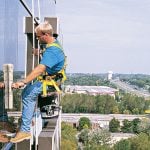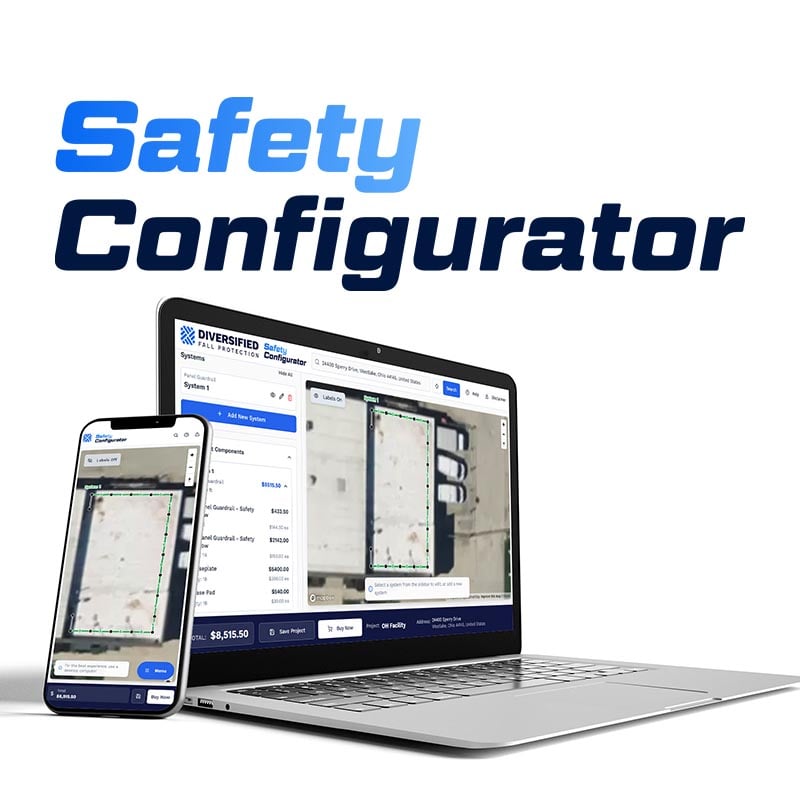New OSHA Regulations for Window Washing Anchors & Rope Descent Systems
 By now, you’ve probably heard about OSHA’s revised Walking-Working Surfaces regulations. Many of the articles published on this topic explore the deadlines to convert from ladder cages to ladder safety systems (we recently published an e-book that discusses the new ladder regulations). Make no mistake—the revised fixed ladder requirements are significant, but the new OSHA regulations cover additional ground that will impact employers and property owners nationwide. In this post, we’ll look at the new Walking-Working Surfaces regulations as they relate to the use rope descent systems (RDS) and window washing anchors.
By now, you’ve probably heard about OSHA’s revised Walking-Working Surfaces regulations. Many of the articles published on this topic explore the deadlines to convert from ladder cages to ladder safety systems (we recently published an e-book that discusses the new ladder regulations). Make no mistake—the revised fixed ladder requirements are significant, but the new OSHA regulations cover additional ground that will impact employers and property owners nationwide. In this post, we’ll look at the new Walking-Working Surfaces regulations as they relate to the use rope descent systems (RDS) and window washing anchors.
Before we dive into our discussion of the new regulations, it makes sense to start with the definition of a rope descent system, which OSHA 1910.27 (b) defines as follows:
“A suspension system that allows a worker to descend in a controlled manner, and as needed, to stop at any time during the descent….the RDS usually consists of a roof anchor, support rope, a descent device, carabiner(s) or shackle(s), and a chair (seatboard).
Prior to the new ruling, OSHA was mostly mum on RDS. You couldn’t find specific language within the older 1910 general industry regulations governing the use of rope descent systems, but OSHA has issued rulings based on a memorandum published back in 1991. The 1991 memorandum specified that a set of basic guidelines for safe RDS use and required that employers:
- Use RDS in accordance with manufacturer instructions
- Implement procedures to ensure employees are properly trained on RDS use and inspection
- Provide a separate anchor for fall arrest and padding for ropes
- Provide a means of prompt rescue
The International Window Cleaning Association’s ANSI/IWCA I-14.1-2001 standard is based on the guidelines set forth in the 1991 memorandum. The provisions of these documents are now incorporated into OSHA 1910.27 (Scaffolds and Rope Descent Systems).
OSHA Anchorage Requirements for RDS
1910.27(b)(1)(i) now requires that before “employers use a rope descent system, the building owner must inform the employer in writing that the building owner has identified, tested, certified, and maintained each anchorage so it is capable of supporting 5,000 pounds in any direction, for each worker attached”. The new regulations also require that the building owner base the information provided to the employer on:
- An annual inspection; and
- A certification of each anchorage, as necessary, and at least every ten years.
In case you are wondering about the certification as necessary language above, OSHA is saying that an accident that damages the anchor, major alterations to the building, or exposure to the elements might require more periodic re-certification.
OSHA also outlines an employer’s responsibilities in 1910.27(b)(ii):
“The employer must ensure that no employee uses any anchorage before the employer has obtained written information from the building owner that each anchorage meets the requirements of paragraph (b)(1)(i) of this section. The employer must keep the information for the duration of the job.”
1910.27(b)(1)(iii) provides employers and building owners with additional time to implement the provisions outlined above, setting a November 20, 2017 compliance deadline to inspect, certify, and maintain each anchor point.
OSHA RDS Design and Work Practice Requirements
1910.27(b)(2)(i) requires that employers ensure no RDS is used at heights above 300 feet above grade. Exceptions to the 300 foot limit are granted when it can be demonstrated that it is not feasible to access heights above 300 feet by other means or in cases where alternative means of access pose a greater hazard than using an RDS.
1910.27(b)(2)(iii) requires employers ensure that each worker who uses an RDS receives training in accordance with OSHA 1910.30. This requirement means an employer must train each worker who uses a RDS in the proper rigging, use, inspection, and storage of the system prior to its use.
1910.27(b)(2)(vi) requires that each worker uses a separate independent personal fall arrest system when using an RDS.
1910.27(b)(2)(vii) requires that employers ensure that all components of each RDS, except seat boards, are capable of supporting a minimum rated load of 5,000 pounds. The final rule requires that seat boards are capable of sustaining a live load of 300 pounds.
1910.27(b)(2)(viii) requires that employers provide for prompt rescue of each worker in the event of a fall. Providing for rescue means employers need to develop and implement a plan for effective rescue. It also obligates employers to provide the resources (e.g., equipment and rescue personnel) and to ensure that employees understand the rescue plan.
1910.27(b)(2)(ix) requires that employers ensure that the ropes of each RDS are effectively padded or otherwise protected where they contact the edges of the building, anchorage, obstructions, or other surfaces to prevent them from being cut or weakened.
1910.27(b)(2)(x) requires that employers provide stabilization at the workers specific work location whenever descents exceed 130 feet. The purpose for stabilization is to reduce the risk of worker injury when longer descents are made using RDS.
1910.27(b)(2)(xi) is a new provision added to the final rule that requires employers to ensure no worker uses an RDS when hazardous weather conditions (e.g., storms, high winds) are present.
1910.27(b)(2)(xii) requires that employers ensure equipment is secured by a tool lanyard or similar method to prevent it from falling. This provision is intended to prevent workers and the public below from being struck by falling equipment.
1910.27(b)(2)(xiii) requires that employers protect RDS ropes from exposure to open flames, hot work, corrosive chemicals, and other destructive conditions that could damage or weaken the ropes.
Next Steps
If you own or lease a building that requires periodic window washing, the most significant changes outlined above revolve around the inspection and recertification of your rooftop anchors. Simply put, you had until fall of 2017 to ensure all of your anchors were capable of supporting 5,000 lbs. in any direction for each attached worker. The only way to definitively make this determination is to pull test each anchor. The new window washing anchor inspection regulations are now in effect, so if you haven’t already made arrangements to have your anchors inspected and certified, give us a call or send an e-mail and we can discuss your options.
Schedule an assessment with Diversified Fall Protection
Contact Us to request a fall safety review

b-1.jpg?width=1368&height=1340&name=Rail%20(175)b-1.jpg)

